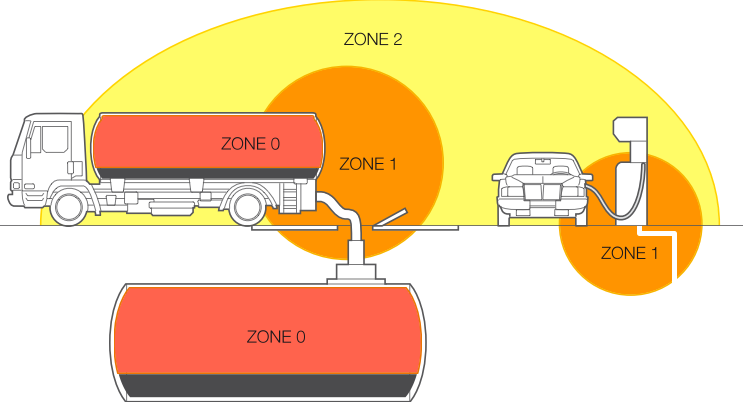What Are EX Zones?
The Engineer’s Map of Explosion Risk (2025)
EX zones are labels (0/1/2 for gas; 20/21/22 for dust) that indicate how often an explosive atmosphere is present at a location, guiding equipment selection and inspection frequency under ATEX/IECEx.
TL;DR
EX zones are the shorthand labels that tell you how often an explosive gas or dust cloud can exist in a location.
Zone 0/20 = continuous hazard,
Zone 1/21 = likely in normal operation,
Zone 2/22 = rare/brief.The zone dictates the minimum ATEX/IECEx equipment category (1G–3G / 1D–3D) and the inspection interval—making zoning the first line of defence against ignition.
1. Why zoning exists
ATEX 153 (1999/92/EC) and IEC 60079-10-1/-2 require employers to classify hazardous areas so that everyone—from design engineers to permit-to-work coordinators—knows which ignition-protected equipment is compulsory.
A correct zone map equals:
- Right equipment → no ignition source
- Right maintenance frequency → integrity preserved
- Right documentation → insurance & legal compliance

2. Gas & Vapour Zones
| Zone | Presence of Explosive Gas Atmosphere | Typical Examples | ATEX Category* |
|---|---|---|---|
| 0 | Continuous or > 1 000 h / yr | Inside fuel tanks, digester head-space | 1G |
| 1 | Likely in normal operation (10–1 000 h / yr) | Pump seals, vent outlets | 2G |
| 2 | Not likely / brief if it occurs (< 10 h / yr) | Well-ventilated pipe flanges | 3G |
*IECEx uses EPL (a, b, c) but the technical protection level is identical.
3. Dust Zones
| Zone | Presence of Explosive Dust Cloud / Layers | Typical Examples | ATEX Category |
|---|---|---|---|
| 20 | Continuous or > 1 000 h / yr | Interior of grain silos, dust collectors | 1D |
| 21 | Likely in normal operation | Around bag filters, mill hoppers | 2D |
| 22 | Not likely / brief | Packing lines, housekeeping sweepings | 3D |
4. How zoning decisions are made
- Identify release sources – vents, seals, filling points, dust collectors.
- Grade each release – continuous, primary, secondary (per IEC 60079-10-1/-2).
- Evaluate ventilation – “good” ventilation can downgrade a zone.
- Draw boundaries – 3-D envelopes on P&IDs and site plans.
- Issue a Hazardous-Area Classification Drawing and Explosion Protection Document (EPD).
5. Why zones matter after commissioning
- Equipment selection – Zone drives EPL (Ex d, e, i etc.) and gas group.
- Inspection interval – EN 60079-17 visual, close or detailed frequency.
- Permits to work – hot-work vs cold-work rules differ by Zone.
- Legal / insurance exposure – mis-zoning invalidates cover; ATEX 153 fines.
6. Updating zones: triggers & best practice
Change the classification if any of the following occur:
- Process chemistry or temperature/pressure changes
- New vents or relief valves installed
- Ventilation altered (ductwork, louvers, fans)
- Dust housekeeping regime downgraded
Modern sites keep the zone map inside a cloud register. EXREG auto-links each equipment record to its zone and flags work orders when zoning changes.
7. Further reading & tools
- ATEX 2014/34/EU (full text)
- ATEX 1999/92/EC (full text)
- What is ATEX? – foundational article
- IECEx Certificate database
8. Frequently asked questions (FAQ)
What is the difference between Zone 1 and Zone 2?
Zone 1 expects an explosive gas atmosphere in normal operation (10–1,000 h/yr), while Zone 2 is unlikely and brief (<10 h/yr). Equipment categories are typically 2G (Zone 1) and 3G (Zone 2).
Who decides the EX zone classification?
The employer/site operator is responsible, usually via a competent engineer following EN IEC 60079-10-1/-2. The outcome is documented in the hazardous-area classification and the Explosion Protection Document (EPD).
Do EX zones set inspection frequency?
Yes. EN IEC 60079-17 uses risk/zone to assign visual, close, or detailed inspection intervals and sampling rates.
How do gas and dust zones differ?
Gas/vapour zones are numbered 0/1/2; dust zones are 20/21/22. The probability scale is identical, but equipment marking uses G (gas) vs D (dust).
Which standard should I cite on drawings?
Use EN IEC 60079-10-1 for gas/vapours and EN IEC 60079-10-2 for dust. Reference both where relevant.
9. Conclusion
EX zones turn abstract explosion probability into concrete design, inspection, and permit rules.
Know your zone → pick the right equipment → schedule the right inspection → avoid ignition. Simple—but only if the zone map stays live.
For inspection intervals and sampling by risk, see our EX inspections guide.
Ready to digitise your EX register?
Start a 7-day EXREG trial
and see your EX register zone counts.
